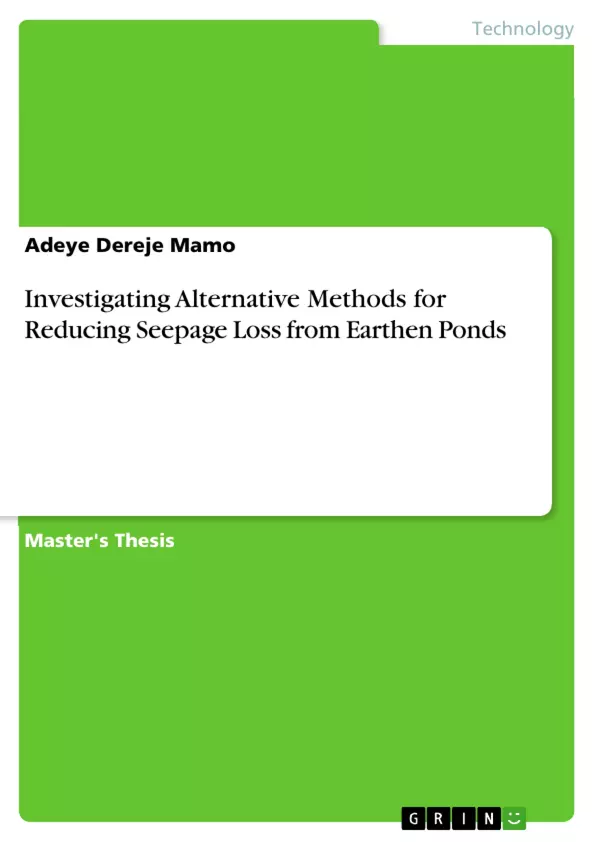Water harvesting technologies are being promoted at the household level in Oromia Region. Among the different types of surface runoff water harvesting structures adopted in the region, earthen pond seems to be the major one practiced by many farmers. Huge numbers of earthen ponds have been implemented to date in different sites. However, the problem of seepage is not adequately addressed; loss of water from the ponds due to seepage and evaporation has been reducing the performance of the ponds. These days, polyethylene membrane has been provided by the government to solve the problem and this membrane has been found to reduce seepage loss by 90%. Unfortunately, the membrane is too costly and not easily available to all farmers.
Therefore, to alleviate the situation, alternative methods of reducing seepage loss were investigated in this experiment. Biological and physical methods for reducing seepage were evaluated in small ponds constructed in permeable silty clay soils of the Region. The biological method involved use of bio-plastic sandwiches made up of successive layers of soil, manure, vegetative material and soil. The physical method involved compacting of existing soil and treating the surface by termite mold mix soil. The biological methods reduced the mean cumulative seepage rate by 47% and the physical treatment reduced by 21% after 90 days of wetting compared to the untreated soil. Therefore, both methods can be cost effectively applied by the farmers.
Inhaltsverzeichnis (Table of Contents)
- 1. INTRODUCTION
- 1.1 Background
- 1.2 Statement of the problem
- 1.3 Objectives of the study
- 1.3.1 General objective
- 1.3.2 Specific objectives
- 1.4 Significance of the study
- 1.5 Scope of the study
- 1.6 Organization of the thesis
- 2. LITERATURE REVIEW
- 2.1 Seepage in earthen ponds
- 2.2 Factors affecting seepage losses
- 2.2.1 Soil texture and structure
- 2.2.2 Depth of pond
- 2.2.3 Water level fluctuation
- 2.2.4 Hydraulic gradient
- 2.3 Methods of reducing seepage losses
- 2.3.1 Lining methods
- 2.3.2 Compaction and grouting methods
- 2.3.3 Chemical treatment
- 2.3.4 Biological methods
- 2.3.5 Other methods
- 2.4 Importance of reducing seepage losses
- 3. MATERIALS AND METHODS
- 3.1 Study area
- 3.2 Experimental set up
- 3.3 Experimental treatments
- 3.4 Data collection
- 3.5 Data analysis
- 4. RESULTS AND DISCUSSION
- 4.1 Physical and chemical properties of soil
- 4.2 Seepage losses from different treatments
- 4.3 Effect of treatment on soil permeability
- 4.4 Discussion
- 5. CONCLUSION AND RECOMMENDATIONS
Zielsetzung und Themenschwerpunkte (Objectives and Key Themes)
This thesis investigates alternative methods for reducing seepage losses from earthen ponds, focusing on the effectiveness of different treatments in minimizing water loss and improving the efficiency of water storage. The study explores the impact of various techniques on soil permeability and examines their practical implications for water conservation in agricultural settings.- Evaluating the effectiveness of different methods for reducing seepage losses from earthen ponds.
- Analyzing the impact of different treatments on soil permeability and water retention.
- Exploring the feasibility and cost-effectiveness of alternative methods for reducing seepage losses.
- Investigating the practical implications of these findings for water conservation in agricultural settings.
- Providing recommendations for the implementation of effective seepage reduction methods in earthen ponds.
Zusammenfassung der Kapitel (Chapter Summaries)
- Chapter 1: This chapter provides an introduction to the research, outlining the background, problem statement, objectives, significance, scope, and organization of the thesis. It highlights the importance of reducing seepage losses from earthen ponds for water conservation and agricultural productivity.
- Chapter 2: This chapter presents a comprehensive review of existing literature on seepage in earthen ponds, exploring the factors affecting seepage losses and different methods for mitigating them. It analyzes various approaches such as lining, compaction, chemical treatment, and biological methods.
- Chapter 3: This chapter details the materials and methods employed in the study. It describes the study area, experimental setup, treatments applied, data collection procedures, and data analysis techniques used to evaluate the effectiveness of different seepage reduction methods.
- Chapter 4: This chapter presents and discusses the results of the study. It analyzes the physical and chemical properties of the soil used in the experiments, examines the seepage losses observed under different treatments, and evaluates the effect of these treatments on soil permeability.
Schlüsselwörter (Keywords)
The study focuses on earthen ponds, seepage losses, water conservation, soil permeability, alternative methods, lining, compaction, chemical treatment, and biological methods. These keywords encapsulate the primary themes and concepts investigated in the thesis.- Citar trabajo
- Dr. Adeye Dereje Mamo (Autor), 2005, Investigating Alternative Methods for Reducing Seepage Loss from Earthen Ponds, Múnich, GRIN Verlag, https://www.grin.com/document/1306339



